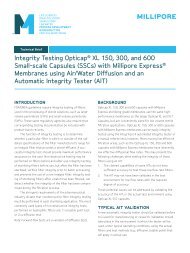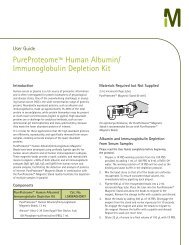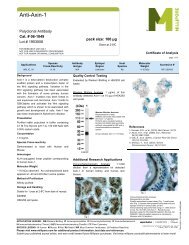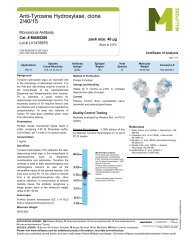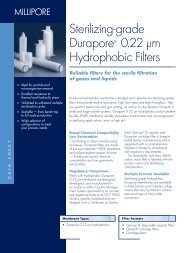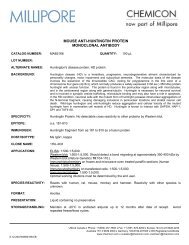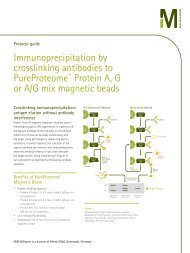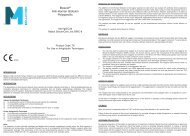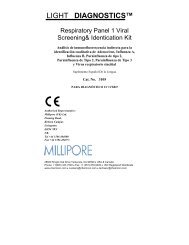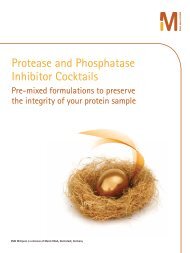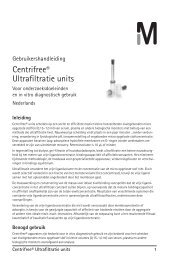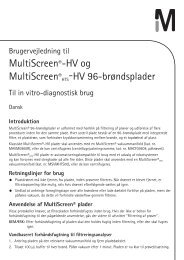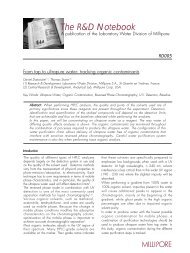MultiScreen Caco-2 assay system - Millipore
MultiScreen Caco-2 assay system - Millipore
MultiScreen Caco-2 assay system - Millipore
You also want an ePaper? Increase the reach of your titles
YUMPU automatically turns print PDFs into web optimized ePapers that Google loves.
Figure 5: Papp vs. Human Absorption —Comparison of <strong>MultiScreen</strong><br />
<strong>Caco</strong>-2 and 24-well Assay Systems<br />
% Human Absorption<br />
Note: The average transport rates used to create Figures 4 and 5 do not include any replicates that<br />
were obvious outliers. This was seen in more than one experiment and occurred in both products.<br />
Reproducibility of Drug Transport Rates<br />
The reliability of cell-based in vitro<br />
methods is contingent upon minimizing<br />
the variability contributed by the cell<br />
growth platform. The use of multi-well<br />
plates for growing cells in long-term<br />
cultures may present a challenge from<br />
both an environmental and industrial<br />
perspective. During culture, even in a<br />
humidity-controlled incubator, elevated<br />
temperatures can cause evaporation<br />
to occur more rapidly in the outer<br />
wells of the plate as compared to the<br />
inner wells. Minor differences in the<br />
seeding of plates from day to day<br />
may also contribute to variability.<br />
Based on these factors, reproducibility<br />
of drug transport rates was examined<br />
in the <strong>MultiScreen</strong> <strong>Caco</strong>-2 <strong>assay</strong><br />
6<br />
100<br />
80<br />
60<br />
40<br />
20<br />
0<br />
1.0x10-7 1.0x10-6 1.0x10-5 1.0x10-4 Equation 3<br />
Equation 4<br />
24 well<br />
<strong>MultiScreen</strong><br />
Papp (cm/sec)<br />
<strong>system</strong> using a 21-day culture of<br />
<strong>Caco</strong>-2 cells and a single drug,<br />
propranolol, in all 96 wells of every<br />
plate tested. Transport rates were<br />
determined in the apical to basolateral<br />
direction. The components of variation<br />
were calculated from the data set<br />
consisting of three experimental runs<br />
performed on different days. Each run<br />
consisted of four different production<br />
lots of Multi-Screen <strong>Caco</strong>-2 plates,<br />
three lots with 96-well feeder trays<br />
(feeder tray from cat. MACA CO2 S5),<br />
and one lot with a single-well feeder<br />
tray (feeder tray from cat. MACA<br />
CO2 B5).<br />
The intra-plate comparison of<br />
propranolol transport in the outer<br />
36 wells versus the inner 60 wells<br />
(intra-plate SD) 2 + (inter-plate SD2 total SD = √<br />
)<br />
95% confidence = (overall plate average) ± (2 • total SD)<br />
was plotted for all 12 plates in this<br />
study (figure not shown). The resultant<br />
R 2 =0.9 confirms that the average<br />
value and variability of the external<br />
wells (n=36) was statistically similar to<br />
the average value and variability of<br />
the internal wells (n=60).<br />
Analysis of variance on the plate<br />
averages, inter-plate and intra-plate<br />
standard deviations (SD) was determined<br />
for all 12 plates. The overall<br />
plate average permeability rate for<br />
these experiments is 1.5 x 10 -5 cm/sec.<br />
The intra-plate and inter-plate standard<br />
deviations are estimated at 0.2 x10 -5<br />
cm/sec and do not vary significantly<br />
among the production lots or test days<br />
(p > 0.07 and p > 0.17, respectively).<br />
Using these values, the total standard<br />
deviation (total SD) of a single<br />
measurement is calculated to be<br />
0.3 x10 -5 cm/sec using Equation 3.<br />
Therefore, 95% of all results from<br />
a propranolol transport experiment,<br />
using the <strong>MultiScreen</strong> <strong>Caco</strong>-2 <strong>assay</strong><br />
<strong>system</strong>, are predicted to fall within<br />
the range determined using Equation 4.<br />
This predicts that 95% of all propranolol<br />
transport rates (apical to basolateral)<br />
in this study should fall within the<br />
range of 0.9 to 2.1 x 10 -5 cm/sec.<br />
These experiments also demonstrate<br />
that the confidence range should be<br />
achieved independent of well position,<br />
plate production lot, type of feeding<br />
tray used, or day of experiment<br />
(Figure 6). A line representing the<br />
upper limit of low permeability<br />
compounds (extrapolated from<br />
Figure 3) is drawn to demonstrate that<br />
the 95% confidence range clearly<br />
distinguishes propranolol as a high<br />
versus a low permeable compound.



